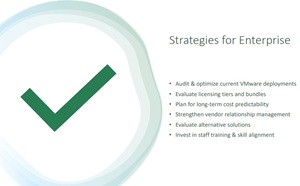In-Depth
6 Enterprise Strategies to Navigate the Post-Broadcom VMware Mess
Broadcom closed its acquisition of VMware in November 2023 and immediately began a business simplification push built around VMware Cloud Foundation, shifting customers from perpetual licensing to subscriptions and consolidating offer bundles.
Broadcom's official updates detail the end of availability for many perpetual SKUs, the emphasis on per-core subscription licensing, and the transition of customer/partner operations into the Broadcom portals and Advantage Partner Program. These moves standardized pricing and packaging but also required customers to re-map entitlements and renewals under the new model, often on new terms and timelines.
From the customer perspective, the aftermath has meant re-forecasting budgets and re-evaluating architectures as SKU consolidation reduced mix-and-match flexibility and subscriptions replaced the old perpetual license plus SnS (annual Support and Subscription) model.
 "The tl;dr: You have to pay more for what you had, buy more cores, and you can't scale down, and you have to buy more features, and Broadcom probably hates having you as a customer. "
"The tl;dr: You have to pay more for what you had, buy more cores, and you can't scale down, and you have to buy more features, and Broadcom probably hates having you as a customer. "
Joey D'Antoni, Principal Cloud Architect at 3Cloud
That's all summed up in a tl;dr provided by official VMWare V-Expert Joey D'Antoni: "You have to pay more for what you had, buy more cores, and you can't scale down, and you have to buy more features, and Broadcom probably hates having you as a customer."
Joey, a working cloud architect, provided that tl;dr in an online tech education summit hosted today by Virtualization & Cloud Review titled "Navigating Post-Broadcom VMware Summit: Top Tips & Strategies." It was sponsored by Nutanix, who also presented at the event and has made the session available for on-demand replay.
Joey delivered the opening session. He brought decades of consulting and enterprise experience to bear on one of the industry's most widely deployed but recently reshaped platforms: VMware under Broadcom ownership.
 [Click on image for larger view.] Enterprise Strategies (source: Joey D'Antoni).
[Click on image for larger view.] Enterprise Strategies (source: Joey D'Antoni).
The Enterprise Challenge
Joey began by setting context: "Enterprises are still adapting to the changes. One of the things that I think is hard, especially if you work in a small organization, for people to understand ... a lot of big customers of VMware have their processes firmly entrenched around VMware." For those organizations, simply switching to another hypervisor or cloud platform is far from trivial.
Since Broadcom acquired VMware in 2022, changes have included a shift from perpetual to subscription licensing, SKU consolidation, higher costs, and reduced support for smaller customers. The impact has been most acute for organizations with limited budgets and smaller VMware deployments.
Audit and Optimize
The first item on Joey's strategy list was straightforward: know exactly what you are running. "You want to understand where VMware is across your environment," he said. "You never want to be surprised in a licensing audit."
He emphasized the importance of inventorying current VMware usage across servers, workloads, and automated processes. This is especially critical because Broadcom has shifted licensing models multiple times in just a few years, making predictable cost planning more difficult.
Evaluate Licensing Tiers and Bundles
Broadcom's consolidation of VMware SKUs has forced customers to purchase higher bundles that include features they may not use. According to Joey, "what this means in a lot of cases, especially for the small customer, is you're going to have to pay for features that you don't really use and don't have any intention of using."
This limits the "mix and match" flexibility VMware once offered, where organizations could selectively purchase components like NSX or vSAN. Today, many of those options are bundled into more expensive editions.
Plan for Long-Term Cost Predictability
Pricing uncertainty has been another recurring theme. Joey described what many enterprises are facing as "inflation in VMware pricing," with increases ranging from 20 to 70 percent depending on the environment. He noted that "it seems like the terms are changing every six to eight months," which complicates budgeting and long-term planning.
For organizations that rely on VMware as foundational infrastructure, these recurring changes make financial forecasting difficult.
Strengthen Vendor Relationship Management
For large enterprises, maintaining a strong relationship with Broadcom is critical. "If you're a big customer, you want to have that relationship with Broadcom, because you're stuck. They're going to care about you because you're a large customer of theirs," Joey explained.
For smaller customers, he recommended looking to other vendors for assistance with migration or optimization, since Broadcom has made it clear that their primary focus is on their largest accounts.
Evaluate Alternative Solutions
Alternatives such as Microsoft Hyper-V, Nutanix, and Proxmox each offer potential paths away from VMware. Joey cautioned that suitability depends on scale: "If you're just running VMs on ESX, you can probably move to Hyper V; you'll probably have some pain points doing it, or one of the other solutions. But if you're wrapped in automation, like vCloud and those sorts of things, you may be stuck for a little while".
Cloud migrations are another option, though cost comparisons have shifted. VMware was long seen as cheaper than cloud deployments, but rising VMware licensing costs have narrowed that gap.
Invest in Staff Training and Skill Alignment
Finally, moving to alternative platforms requires investment in people. Joey stressed the need to "get your staff up to speed on them and make sure they kind of understand what the scenarios are there. Whether transitioning to Nutanix, Hyper-V, or a hybrid cloud model, training is essential to avoid operational setbacks.
The Bottom Line
For Joey, these six enterprise strategies form the core of navigating VMware in the Broadcom era. Auditing and optimizing environments prevents surprises, licensing evaluation and cost planning help with predictability, vendor management and alternative evaluations provide options, and staff training ensures organizations can adapt.
"Proactively planning is going to help you avoid cost overruns," he said. While VMware remains a strong platform technically, the business environment around it has changed. For enterprises, adaptation is no longer optional--it is a requirement."
And Much More
Those are all concise summaries, of course, and you need to watch the on-demand replay to get the individual items fleshed out in detail -- along with many other actionable tips -- but this gives you the overall idea of Rivas' presentation.
For more detail, watch the on-demand replay of the summit here.
And, although replays are fine -- this was just today, after all, so timeliness isn't an issue -- there are benefits of attending such summits and webcasts from Virtualization & Cloud Review and sister pubs in person. Paramount among these is the ability to ask questions of the presenters, a rare chance to get one-on-one advice from bona fide subject matter experts (not to mention the chance to win free prizes, in this case a GoPro HERO13 provided by Nutanix).
With all that in mind, here are some upcoming webcasts coming up in the next month or so from our parent company:
About the Author
David Ramel is an editor and writer at Converge 360.